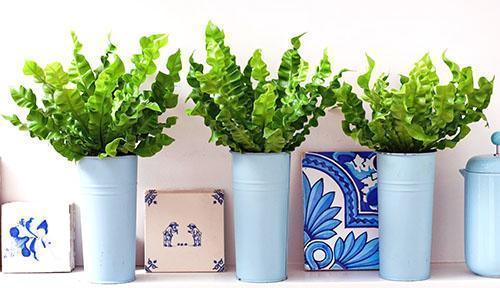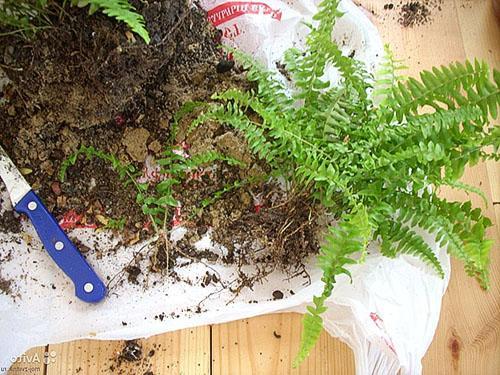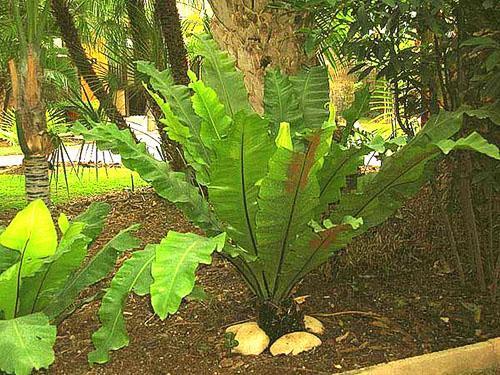Reproduction methods of different plant species asplenium
 Asplenium is used as a houseplant because of the beauty of its huge leaves, which can reach almost a meter in length. Its leaves are special, complex and are called vayi. The tropical plant asplenium requires light, warmth and constant care in its care. Of the many species, only a few were able to exist at home. Asplenium perfectly cleans the air of the room, at the same time filling it with oxygen.
Asplenium is used as a houseplant because of the beauty of its huge leaves, which can reach almost a meter in length. Its leaves are special, complex and are called vayi. The tropical plant asplenium requires light, warmth and constant care in its care. Of the many species, only a few were able to exist at home. Asplenium perfectly cleans the air of the room, at the same time filling it with oxygen.
Asplenium breeding methods

 The nesting asplenium, the most common inhabitant of apartments and relatively patient in care, is multiplied by dividing the rhizome during transplantation, since it gives side shoots.
The nesting asplenium, the most common inhabitant of apartments and relatively patient in care, is multiplied by dividing the rhizome during transplantation, since it gives side shoots.
 In culture, it is found, but asplenium asaka has not received wide distribution, the fronds of which look like long feathers, wavy at the edges. This type of asplenium reproduces by spores growing on the underside of the leaves.
In culture, it is found, but asplenium asaka has not received wide distribution, the fronds of which look like long feathers, wavy at the edges. This type of asplenium reproduces by spores growing on the underside of the leaves.
These are the preferred species for breeding domestic ferns.
Conditions for breeding asplenium
 Whichever way indoor plants propagate, the best time is spring. At this time, the life processes of living organisms are naturally activated. All transplants, reproduction are carried out after the winter rest of the plants.
Whichever way indoor plants propagate, the best time is spring. At this time, the life processes of living organisms are naturally activated. All transplants, reproduction are carried out after the winter rest of the plants.
It is important to create a temperature close to 20 0 in the substrate and air. Warm, moist soil speeds up the germination or rooting of plants.
Soft, light soil is used to grow new plants. It consists of:
- leaf land - 2 parts;
- peat - 1 part;
- humus - 2 parts;
- sand - 1 part.
Traditionally, as for all tropical plants, charcoal and vermiculite are added to the soil. For new plants, it is better to replace moss as an ingredient for ferns with coconut fiber.
For growing plants from spores and viviparous buds, a cradle with a flat surface is prepared. The lower drainage layer is slightly covered with a peat substrate, and asplenium seeds are sown on such a substrate. Each of the breeding methods requires specific skills.
Reproduction of asplenium by dividing the bush
 The division of the bush occurs in the spring. If a large bush has grown and there is not enough space in the pot for nutrition, the bush requires a transplant. It's time to start breeding.
The division of the bush occurs in the spring. If a large bush has grown and there is not enough space in the pot for nutrition, the bush requires a transplant. It's time to start breeding.
All parts of the plant are fragile. Therefore, removing the asplenium for reproduction from the container, you need to treat it with care.
 You need to know that after dividing an adult plant, its growth will not be restored soon. The root system is difficult to adapt to new conditions. Therefore, only a bush can be divided, in which new growth points are formed on the rhizome in many. If there are few of them, then all divisions and an adult plant may die.
You need to know that after dividing an adult plant, its growth will not be restored soon. The root system is difficult to adapt to new conditions. Therefore, only a bush can be divided, in which new growth points are formed on the rhizome in many. If there are few of them, then all divisions and an adult plant may die.
After transplanting, you need to be patient and wait for the roots to work again. In this case, the utensils for transplantation should be wide and slightly cramped.The property of these plants to first occupy the entire proposed land, and only then to grow leaves should be taken into account. For planted plants, a pot about 7 cm in diameter is chosen, since young plants are often transplanted as the roots develop. Each time the substrate is replaced and the volume of the pot increases.
 Sequence of operations for rooting:
Sequence of operations for rooting:
- Pre-soaked expanded clay is placed in a container with drainage holes, or better, pieces of polystyrene mixed with bog moss.
- A layer of prepared earth is poured, you can use soil for orchids, with vermiculite and chopped moss.
- A separated bush with a root system treated against rot is planted in a prepared glass, leaving the neck not covered.
- The roots of the plant are arranged neatly, sprinkled with soil just above the neck, without compaction.
- Water the new plant abundantly, with soft water, settled for 12 hours, while the soil will settle, exposing the neck.
- The rest of the water should leave the container through the drain.
Only nesting asplenium planted for reproduction is closed on top with a transparent bag, but they are not tied at the bottom, allowing air to enter. During rooting, make sure that the ground is slightly damp, watered with droplets from above, preventing root decay. Rooting can take 3-7 weeks, depending on the variety and the warmth of the air and soil. After the appearance of young greenery, the package is removed gradually in order to accustom the plant to habitat conditions.
Reproduction of viviparous asplenium
 This type of fern differs from others in the formation of brood buds on fronds. In nature, a small plant, ready to continue, falls into the ground and gives off shoots. A cultivated plant is bred without waiting for the sprout to fall, when several leaves have formed on it. It is torn off together with a piece of leaf and laid on the surface of the substrate, slightly sprinkled with a thin layer of earth and slightly moistened with a spray.
This type of fern differs from others in the formation of brood buds on fronds. In nature, a small plant, ready to continue, falls into the ground and gives off shoots. A cultivated plant is bred without waiting for the sprout to fall, when several leaves have formed on it. It is torn off together with a piece of leaf and laid on the surface of the substrate, slightly sprinkled with a thin layer of earth and slightly moistened with a spray.
 If a young seedling has taken root in a pot on its own, it is carefully removed and planted. Such a plant develops quickly, it is necessary to cover it only in the first two weeks, so that the ground on the surface does not dry out until the roots go into the depths. The transplant into a separate dish should be done after the first leaves are grown up to 4 cm. When viviparous asplenium is multiplied, the bowl should be wide, and several plants can be planted, but so that they do not interfere with each other. The next time you change land, you can plant them one at a time.
If a young seedling has taken root in a pot on its own, it is carefully removed and planted. Such a plant develops quickly, it is necessary to cover it only in the first two weeks, so that the ground on the surface does not dry out until the roots go into the depths. The transplant into a separate dish should be done after the first leaves are grown up to 4 cm. When viviparous asplenium is multiplied, the bowl should be wide, and several plants can be planted, but so that they do not interfere with each other. The next time you change land, you can plant them one at a time.
Growing asplenium from spores
 Reproduction by spores is rarely used. The method is time consuming, the process is lengthy. Disputes when sold in specialized stores are called asplenium seeds. This seed can be obtained all season during the growing season. Sporangia, in which spores of the bone plant develop, are located on the back of the leaves, creating a brown coloration of the plate. In order to collect them, it is enough to scrape off the sporangia on a piece of paper and dry in a paper envelope.
Reproduction by spores is rarely used. The method is time consuming, the process is lengthy. Disputes when sold in specialized stores are called asplenium seeds. This seed can be obtained all season during the growing season. Sporangia, in which spores of the bone plant develop, are located on the back of the leaves, creating a brown coloration of the plate. In order to collect them, it is enough to scrape off the sporangia on a piece of paper and dry in a paper envelope.
 You will need to find a warm and shaded place to install the mini-plate, or create moisture under a glass cover above the bowl. The germination process is long, from a month to three. Necessarily warm, moist substrate during germination on a thin layer of peat, laid on a brick, immersed in water 5 cm.
You will need to find a warm and shaded place to install the mini-plate, or create moisture under a glass cover above the bowl. The germination process is long, from a month to three. Necessarily warm, moist substrate during germination on a thin layer of peat, laid on a brick, immersed in water 5 cm.
The liquid should be added as it evaporates. Daily ventilation of the greenhouse is required. It is important that the brick is freshly calcined, the moss is decontaminated, and the distilled water goes through the distillation unit and is stored in a glass flask with paraffin inside. Distillate can be purchased at a laboratory or pharmacy.
Pour the contents of the bag onto wet peat. When dense greenery appears, arrange backlighting. When the leaves grow back, the plants are thinned out, leaving 2.5 cm between the seedlings.Upon reaching a leaf blade the size of a matchbox, the plants are planted in pots, 2-3 pieces can be in one container.
 In this way, aspleniums can be grown from spores for landscaping the landscape of a country house. Then several plants are planted in flowerpots for splendor.
In this way, aspleniums can be grown from spores for landscaping the landscape of a country house. Then several plants are planted in flowerpots for splendor.